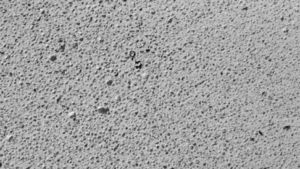About 30 years ago, it became known that the lifespan of RAAC in many public buildings, including hospitals and schools was no greater than 30 years.
In the 1990s, when the material was still being used, structural engineers discovered that the strength of RAAC was not standing the test of time.
The porous, sponge-like concrete – especially when used on roofs – could easily absorb moisture, weakening the material and also corroding steel reinforcement within.
Yet it seems, not much happened.
Until 2018 when the roof of a primary school in Gravesend, Kent suddenly collapsed. Thankfully, it happened on a weekend, and no one was injured. Adkins were involved in diagnosing straight after the collapse and diagnosing the problems at the school.

Figure 1 Section Through RAAC
In this case there had been some roofing problems, water had saturated the RAAC. and was lying in the roofing felt layers making it far heavier, which also contributed to the collapse.
Adkins reported the problems at the time. Due to the experience as we have had with this type of failure and due to the numerous previous RAAC surveys we have completed we will be pleased to offer our services going forward with surveys and diagnostic work.







